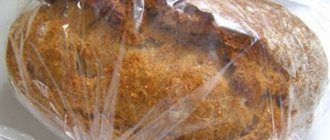Author of the article:
Muzyko Tatyana Andreevna - lawyer.
The shelf life of flour directly depends on storage conditions. Special production-scale facilities keep it suitable for consumption for 10 years.
There are no such opportunities at home or at retail establishments. Therefore, the period is reduced to a maximum of 2 years from the date of manufacture.
According to GOST
- GOST 26791-89 “Grain processing products. Packaging, labeling, transportation and storage” applies to flour, cereals, flakes, oatmeal, and food bran.
- GOST R 52189-2003, GOST R52809-2007, GOST 14176-69 “Wheat, rye, corn flour. General technical conditions" - justification for the production of grain products.
- GOST R 31645-2012 “Flour for baby food. Technical conditions" applies to products obtained from rice, oat, and buckwheat cereals, thermally untreated, requiring cooking, intended for quick preparation of dishes.
- SanPiN 2.3.2.1078-01 “Hygienic requirements for safety, nutritional value.”
- SanPiN 2.3.2.1324-03 “Hygienic requirements for shelf life and storage conditions.”
Timing and types
Each type has its own composition and corresponds to the source material. Factors influencing the duration of storage: quality of grinding, packaging and room conditions (temperature, humidity, ventilation, proximity of substances with odors).
| Name | Tara | Place | ||
| Temperature °C | Humidity % | Neighborhood | ||
| Wheat | From paper, fabric, plastic | +5-15 | 60-70 | No foreign odors |
| Rye | Glass or plastic | 20 | 70 | |
| Linen | Vacuum packaging | +5-10 | ||
| Corn | Hermetic | +5-15 | 60-70 | |
| Oatmeal | Paper "breathable" | +20 | 60 | |
| Buckwheat | Made from fabric, paper | Up to +25 | 70 | |
| Pea | From paper or fabric | Up to +25 | 70 | |
| Pumpkin | Factory | +5-15 | 60-70 | |
| Barley | Glass, metal, tightly closed | up to +18 | 60 | |
| Rice | Glass, hermetically sealed | +5 — 15 | 60 | |
| Meat and bone | Tightly sealed packaging | Up to +30 | 75 | Not limited |
| Fish | Tightly closed | +20-30 | 75 | |
Storage conditions
Wheat is ground wheat grains. According to GOST, the time of use is set by the manufacturer. The labeling must contain the release date and shelf life. Usually this is 6 months, the highest grade - 12. Factory packaging is suitable until opened. Supplies are kept in a sealed container to avoid contact with air. The refrigerator will extend the shelf life.
Dear readers! To solve your problem right now, get a free consultation
— contact the lawyer on duty in the online chat on the right or call: +7 (499) 938 6124 — Moscow and region.
+7 (812) 425 6761 — St. Petersburg and region. 8 (800) 350 8362 - Other regions of the Russian Federation You will not need to waste your time and nerves
- an experienced lawyer will solve all your problems!
Rye becomes moldy due to high humidity and becomes unusable. When kept dry and cool, it can be used for 6 months. The product adsorbs well, which prevents the proximity of strong-smelling substances. Glass, paper or fabric containers will ensure reliable storage. Garlic cloves will protect against bugs.
Rich in fiber, flax seed product has a high degree of antioxidants. Storage in original vacuum packaging is recommended. The beneficial properties expire after 10 months. A longer period indicated on the label indicates chemical additives. The preferred storage location is a refrigerator, basement, cellar at a temperature of +5...10 ° C, the absence of moisture is necessary.
Corn is made from corn kernels. Fine grinding is suitable for 3 months from the date of production. Refrigerated storage is recommended. The packaging can be anything, as long as it is tightly closed. Glass and fabric containers have an advantage over plastic ones. To avoid the settlement of barn bugs, you can put marigold inflorescences inside the package. The wet flour is scattered and dried.
Important : after opening the original container, you need to stick a date sticker on the storage container.
Dietary product made from oats is used in baby food. The room must be clean, dry and free of foreign odors. When making a purchase in a store, you need to pay attention to the neighboring products: if they are flavored, it is better not to purchase flour. Bay leaves placed near the package will help protect the contents from insects.
Buckwheat, after hulling, grinding and sifting, becomes buckwheat flour. This is a dietary product with a shelf life of 6 months. Recommended containers are paper bags, fabric bags, which are kept in a saline solution before use. The room must be at a constant temperature, dry, and ventilated.
The shelf life of pea flour ends 8-10 months after production. Do not leave it open, in a damp place, or in direct sunlight. This leads to spoilage of the product: musty smell, bitterness. It is better not to open the original packaging before cooking. At home they are stored in paper and fabric bags. A closet under the window, a cool pantry are the best places to keep it.
Pumpkin can consist of various parts of the vegetable: seeds, pulp. Shelf life – 6 months. It has a dark green color, taste and smell of pumpkin seeds. Sold hermetically sealed. The conditions of detention do not differ from grinding of other types. Dryness, darkness, low temperatures will help preserve beneficial properties.
A by-product of crushing barley is flour. It contains fiber, protein, vitamins. Used as an additive to wheat in baked goods and protein shakes. Stored in a dark, dry, cool place for up to 6 months. A metal object inside the container will prevent insects from appearing.
Rice is the raw material for the production of rice flour. Shelf life: 6 months. A refrigerator and a tightly closed container will help not to waste the properties of the product. A warm, humid environment leads to mold and loss of nutritional value. If there are bugs, it is disposed of: the required qualities after insects cannot be restored.
Important: checking the release date and expiration date on the packaging is never superfluous.
Preparation for storage
It should be understood that storage on an industrial scale is fundamentally different from the conditions that are available to every person in their own kitchen. That is why special attention is paid to preliminary product quality control, which is carried out according to a number of parameters:
- absence of any impurities in the product;
- homogeneity and uniformity of the substance;
- absence of insects and other pests;
- the correct color depending on its class;
- proper flour storage temperature.
If the product meets all these parameters, then it is allowed for subsequent storage. It is noteworthy that it is at the stage of primary storage that the flour becomes lighter due to its ripening. This happens due to the occurrence of gas exchange processes in it, which affect not only the color change, but also the level of fiber contained in it, which is constantly growing.
During this period, the flour “breathes”, due to which a large number of microorganisms appear in it. This is one of the reasons that it is at this time that it is necessary to carefully monitor temperature and humidity indicators in order to protect the product from spoilage. Under the right storage conditions, flour retains its original properties and for a long time can avoid the risks of aging, which directly affect the final quality of the product available to everyone on store shelves.
On an industrial scale, there are two main storage methods:
- Storing flour in bags. This option is used in cases where its volume is insignificant. In this case, the bags themselves are stored in rows, several pieces on top of each other. This can often be observed in bakeries, where products are stored for a fairly short period of time. Provided the proper temperature and humidity are maintained, this method fully meets the necessary requirements and allows the manufacture of various products from it with minimal risk of loss of quality.
- Bulk storage. This technique is used in large industry and in many ways resembles the principle of a granary. Proper storage requires a myriad of tools, from storage silos to air conditioning systems, temperature sensors and automatic loading and unloading lines. In this case, impeccable conditions are ensured, so the shelf life of the products reaches its maximum possible.
When stored in bulk, subject to temperature conditions and controlled humidity levels, the shelf life of flour can reach two years, which is almost twice as long as with traditional storage in bags or smaller containers.
Nuances with animal flour
Protein is required for complete nutrition of domestic animals and poultry. By processing natural waste from slaughterhouses and fisheries, a feed additive is obtained.
Fish
The basis is fish waste. Shelf life: 6 months at 18% fat, one year at less. Conditions of keeping: closed containers, inaccessible to animals.
A room with a temperature no higher than +30 °C, humidity no more than 75%. The biological content of the product does not allow storage in a hot room. After the expiration date, a putrid odor, caking of the product, and color change appear.
Meat and bone
Feed flour is an additive for animals and birds. Made from canned animal waste. Stored in original packaging, the opened part must be secured with clamps after use.
Can be placed in a closed container. The utility unit or warehouse must be well ventilated, dry, and have a temperature of up to +30 °C.
When overheated, the fat contained in flour decomposes, resulting in toxicity. Spoiled product should not be given to animals. The expiration date indicated on the packaging is 1 year.
Insect protection
There are old, time-tested methods of protecting against insects that love to live in flour.
- If you plan to use cotton bags for storage, then before pouring the flour into the bag, soak it in a concentrated salt solution (3 tablespoons per 1 liter of water) and dry it well (no need to rinse in clean water). The salt will repel moths and bugs, and the flour will be safe.
- The most affordable way to protect against pests is to put a few unpeeled cloves of garlic in the flour. Use 2 slices per 1 kg. flour. Volatile substances (phytoncides), which garlic contains in large quantities, effectively repel insects.
- There is another method of combating flour bugs - dried calendula flowers. Calendula is poured into a large bag, into which a smaller bag of flour is placed. This way the flowers will not get into the flour and will repel insects.
- Bay leaves will help repel pests. Interestingly, having a pronounced odor, it will not harm the flour.
- A modern way to protect flour supplies from visits from uninvited guests is to use mint chewing gum. If you put several open packs of mint gum next to the bag, insects will not get into it.
- The shelf on which the bag of flour is stored should be treated with acetic acid once every 7 days.
- If it happens that pests have already settled in the flour, do not despair. It can be sifted through a fine-mesh sieve and poured again into another container. To ensure that all insects are killed, the flour can be placed in the oven. Heat treatment should be carried out for 10 -15 minutes at a temperature of +100°C.
- You cannot use a container in which pests have infested - they may come back again. Therefore, before reuse, the container is thoroughly washed and rinsed with a salt solution. After complete drying, the container can be reused.
How to increase shelf life
To extend the period, you must follow generally accepted rules.
- Store in original packaging until use.
- If the container is hermetically sealed, it can be stored in the refrigerator.
- After opening, it is poured into paper bags, fabric bags soaked in salt, glass jars, and plastic containers.
- Optimum temperature +6…15 °C, humidity 60-70%.
- Direct contact with air, sunlight, and high temperature is undesirable.
Important: storage at temperatures from 0 °C and below increases the preservation of consumer qualities up to 2 years!
To prevent insects from appearing, there are natural repellents:
- unpeeled garlic cloves;
- Bay leaf;
- dried cloves;
- calendula inflorescences;
- metal objects.
If the flour feels cold to the touch at room temperature, it is wet. It should be placed in a layer of 5-7 cm and dried, sifted through a sieve, and placed in a dry, hermetically sealed container.
Is there any point in keeping it in the refrigerator?
The product may be placed in a refrigerator or freezer. This is especially true for varieties with a high content of fats and natural oils (whole grains), the taste of which can become rancid over time. Remember that flour does not tolerate sudden changes in temperature, as it will quickly become damp due to the condensation that forms. If this does happen, lay it out on a sheet of paper and dry it next to the switched on gas stove. It is recommended to defrost gradually, first placing it on the refrigerator shelf, and only after a couple of hours can it be placed at 20°C.
Using a refrigerated cabinet allows you to extend shelf life by several months.
How to find out what has gone bad
Cereals and legumes contain large amounts of fat. Over time, they lose their qualities, grow old, and deteriorate. Also, before purchase, the goods could have been stored in warehouses that did not always meet the requirements, and how long they stayed there is unknown.
Signs of depravity:
- the smell of bitterness;
- mold smell;
- the smell of sour dough;
- rolling into lumps;
- color change;
- the appearance of a large number of insects.
Important: to avoid spoilage of the product, you should think about the advisability of buying flour in reserve.
Is it possible to use expired
To preserve your own health, you should not consume products that have expired. Flour is no exception. Violation of storage technology and expired use are fraught with the appearance of mycotoxins that can have a detrimental effect on the human body.
Potato stick leads to the development of endocarditis, peritonitis, meningitis, inflammation of the intestines, joints, gall bladder, food intoxication (poisoning with nausea, vomiting and disorder), allergic reactions. The use of such a product is strictly prohibited.











